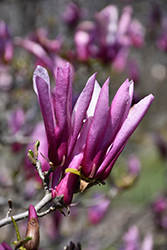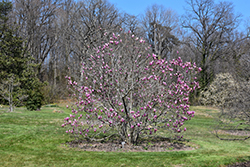It's all about ...
plants

Height: 20 feet
Spread: 15 feet
Sunlight:
![]()
![]()
Hardiness Zone: 6a
Description:
An exquisitely beautiful magnolia with liliiflora-like violet-pink blooms that are crimson at the base; a small tree or large shrub with a tidy form; flowers in mid-spring; an ideal landscape or garden accent
Ornamental Features
Orchid Magnolia is covered in stunning fragrant pink cup-shaped flowers with violet overtones and crimson centers held atop the branches from early to mid spring, which emerge from distinctive coppery-bronze flower buds before the leaves. It has dark green deciduous foliage. The pointy leaves turn coppery-bronze in fall.
Landscape Attributes
Orchid Magnolia is a deciduous tree with a distinctive and refined pyramidal form. Its relatively coarse texture can be used to stand it apart from other landscape plants with finer foliage.
This is a relatively low maintenance tree, and should only be pruned after flowering to avoid removing any of the current season's flowers. It is a good choice for attracting birds to your yard. It has no significant negative characteristics.
Orchid Magnolia is recommended for the following landscape applications;
- Accent
- Shade
- Hedges/Screening
Planting & Growing
Orchid Magnolia will grow to be about 20 feet tall at maturity, with a spread of 15 feet. It has a low canopy with a typical clearance of 2 feet from the ground, and is suitable for planting under power lines. It grows at a medium rate, and under ideal conditions can be expected to live for 50 years or more.
This tree does best in full sun to partial shade. It requires an evenly moist well-drained soil for optimal growth, but will die in standing water. It is not particular as to soil type, but has a definite preference for acidic soils. It is quite intolerant of urban pollution, therefore inner city or urban streetside plantings are best avoided. Consider applying a thick mulch around the root zone in winter to protect it in exposed locations or colder microclimates. This particular variety is an interspecific hybrid.
This plant is not reliably hardy in our region, and certain restrictions may apply; contact the store for more information.

